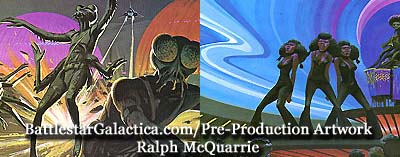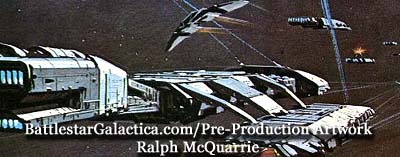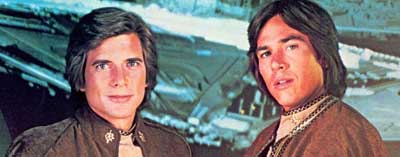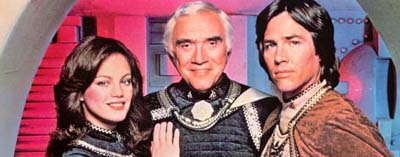Battlestar Galactica History

Opening narration for the television version of "Saga of a Star World"
(Battlestar Galactica pilot episode):
"There are those who believe... that life here... began out there. Far across the universe. With tribes of humans... who may have been the forefathers of the Egyptians... or the Toltecs... or the Mayans... that they may have been the architects of the Great Pyramids... or the lost civilizations of Lemuria... or Atlantis... Some believe that there may yet be brothers of man... who even now fight to survive... somewhere beyond the heavens."

And thus began the saga of the Colonial battlestar Galactica and her rag tag fleet each week. The story behind this powerful character-driven epic began on September 17, 1978 on ABC-TV (U.S.A.). The story unfolds in a distant galaxy as Mankind has reached its Seventh Millenia of recorded history. Twelve (12) worlds in a multi-star system are home to the Twelve Colonies of Man. According to the ancient writings, the Twelve Colonies were settled by those who journeyed from a mother world, Kobol. Of particular note: a thirteenth tribe of humans moved across the stars to settle another world: Earth. By the present Colonial day in the series, Earth was considered a myth and little was known about the Colonials' true origins, save for the writings in the Book of Kobol (the Colonials' "bible"). It is unknown how the Colonials came to know about Earth, since they did not appear to maintain communications with their distant brethren.

Set in a distant galaxy, Mankind has reached its Seventh Millenia of recorded history. Twelve (12) worlds in a multi-star system are home to the Twelve Colonies of Man. According to the ancient writings, the Twelve Colonies were settled by those who journeyed from a mother world, Kobol. Of particular note: a thirteenth tribe of humans moved across the stars to settle another world: Earth. By the present Colonial day in the series, Earth was considered a myth and little was known about the Colonials' true origins, save for the writings in the Book of Kobol (the Colonials' "bible"). It is unknown how the Colonials came to know about Earth, since they did not appear to maintain communications with their distant brethren.
For the past one thousand years (yahrens), Man has fought the robotic Cylon Alliance. (According to Commander Adama, it began when the Colonies intervened in Cylon aggressions against the Hassarians in a neighboring star system.) During the introduction of the series, we see that the Colonies are united by a President (Adar) and governed by The Council of the Twelve, a ruling body comprised of one representative from each Colonial world. The state of war is ever-present.
The Colonies have deployed space-borne military defenses against the Cylons (and unseen hostiles, such as pirates). The strongest of these defenses are the Colonial battlestars. At the start of the series, the Commander Cain, the battlestar Pegasus and the Fifth Fleet are presumed destroyed two yahrens earlier at the Battle of Molocay. Council member Baltar has struck a peace agreement with the Cylons. He has convinced President Adar and the rest of the Council of the Twelve to accept the Cylons' word. Only Adama of the battlestar Galactica shows concern and muted resistance. The Colonial fleet is gathered as a peace envoy under a joint Cylon/Colonial truce.

When the series begins, we see the Cylons deploying a Trojan Horse strategy against the Colonies: Under the guise of peace, the Colonial military is ambushed and destroyed (with the Galactica able to survive by retreating) while the unprotected civilian populations are assaulted. With no hope of survival against overwhelming Cylon forces--and no true defensive capability remaining--a handful of surviving Colonials flee the Twelve Colonies in civilian starcraft. Under the command of Adama on the Galactica, they head into deep space, searching for the Thirteenth Tribe of Man who are "on a shining planet known as Earth."

The Cylons move into the Colonial worlds. While rounding up prisoners, they discover that surviving Colonials have fled to the stars. The Cylons' Imperious Leader orders Baltar to finish his mission of destroying the Colonials. He provides him with the necessary Cylon forces to do the job. It is up to the intrepid crew of the Galactica to lead the Colonial survivors to safety while encountering new friends and foes, tackling internal strife and starvation, and outmaneuvering Baltar and pursuing Cylon forces.
Susan J. Paxton (Kobol.com/Battlestar Zone) writes, "Battlestar Galactica was a series with no background. No time was spent thinking out the history and culture of the Colonies, and it shows. Tantalizing bits of information appeared in the scripts and were never developed. We know, for one, that the normal Colonial lifespan was 200 yahren. What effect would such longevity have on people, on institutions such as marriage, on jobs, on birthrates? Having more to lose if they died, would people be more cautious? This is only one example, yet in spite of their alien culture, the Colonials are transplanted 1970s Americans. Though the major background mysteries of Battlestar Galactica are beyond solution, the minor ones are worth trying to explain even now."

According to series creator Glen A. Larson, "'Galactica' has a biblical feel. It ties in with Genesis, it ties in with the western pioneers. That's why we can do people stories even though we're in space. It's not a hardware show, although the special effects are magnificient." (Jerry Buck, The San Diego Union TV Week, September 17-28, 1978.)
Consider this: In it's day, Battlestar Galactica (BSG or BG, depending on your preference) was a cutting-edge science fiction television show. The budget was enormous ($1 million per episode; twice the rate for one-hour series in 1978) and new science fiction ideas were introduced on television. With Battlestar Galactica, there was very little background foundation established, though. The 1970s television writing mentality was not very flexible. The introduction of heavy story subtext was frowned upon. Unlike other recent science fiction successors, such as Babylon 5 and The X-Files, that era of television writing did not address intelligent users with multi-story threads, backgrounds and ongoing, expanding subplots (aside from the Cylons chasing the Colonials).
While fans have divided views on this topic, we strongly recommend that you read Richard Hatch's "Battlestar Galactica: Armageddon" ,"Battlestar Galactica: Warhawk", "Battlestar Galactica: Resurrection" and "Battlestar Galactica: Rebellion" books. You will gain a better understanding of events within the Battlestar Galactica universe. Both Mr. Hatch and his co-authors expand upon the original concepts of the BG universe with plausible ideas. Who were the Lords of Kobol? Who are the Ships of Light and what is their connection to the Colonials? How does Count Iblis factor into all of this? Why did the original Cylons evolve from organic beings towards robotic vessels of war? What new allies and enemies await the Colonials in uncharted space? How will a new generation of space-borne Colonials (who never knew the holocaust faced by their parents) deal with their plight? How has the Colonial rag tag fleet grown? What technological innovations have taken place with limited resources? Where is the Thirteenth Tribe... and Earth? Read the books for insights into these questions and MUCH more.